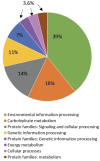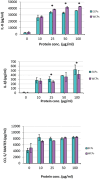Secretome analysis and virulence assessment in Abiotrophia defectiva
- PMID: 38352067
- PMCID: PMC10863525
- DOI: 10.1080/20002297.2024.2307067
Secretome analysis and virulence assessment in Abiotrophia defectiva
Abstract
Background: Abiotrophia defectiva, although infrequently occurring, is a notable cause of culture-negative infective endocarditis with limited research on its virulence. Associated with oral infections such as dental caries, exploring its secretome may provide insights into virulence mechanisms. Our study aimed to analyze and characterize the secretome of A. defectiva strain CCUG 27639.
Methods: Secretome of A. defectiva was prepared from broth cultures and subjected to mass spectrometry and proteomics for protein identification. Inflammatory potential of the secretome was assessed by ELISA.
Results: Eighty-four proteins were identified, with diverse subcellular localizations predicted by PSORTb. Notably, 20 were cytoplasmic, 12 cytoplasmic membrane, 5 extracellular, and 9 cell wall-anchored proteins. Bioinformatics tools revealed 54 proteins secreted via the 'Sec' pathway and 8 via a non-classical pathway. Moonlighting functions were found in 23 proteins, with over 20 exhibiting potential virulence properties, including peroxiredoxin and oligopeptide ABC transporter substrate-binding protein. Gene Ontology and KEGG analyses categorized protein sequences in various pathways. STRING analysis revealed functional protein association networks. Cytokine profiling demonstrated significant proinflammatory cytokine release (IL-8, IL-1β, and CCL5) from human PBMCs.
Conclusions: Our study provides a comprehensive understanding of A. defectiva's secretome, laying the foundation for insights into its pathogenicity.
Keywords: Abiotrophia defectiva; infective endocarditis; oral infections; proteomics; secretome.
© 2024 The Author(s). Published by Informa UK Limited, trading as Taylor & Francis Group.
Conflict of interest statement
No potential conflict of interest was reported by the authors.
Figures





References
-
- Rhodes HM, Hirigoyen D, Shabnam L, et al. Infective endocarditis due to abiotrophia defectiva and granulicatella spp. complicated by infectious intracranial cerebral aneurysms: a report of three cases and review of the literature. J Med Microbiol. 2016;65(6):493–9. doi: 10.1099/jmm.0.000260 - DOI - PubMed
LinkOut - more resources
Full Text Sources
Molecular Biology Databases
